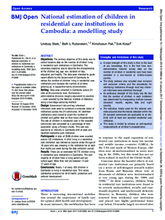Abstract
Objectives The primary objective of this study was to collect baseline data on the number of children living in residential care institutions in Cambodia. The secondary objective was to describe the characteristics of the children (eg, age, sex, duration of stay, education and health). The data were intended to guide recent efforts by the Government of Cambodia to reduce the number of children living in residential care institutions and increase the number of children growing up in supportive family environments.
Setting Data were collected in Cambodia across 24 sites at the commune level. Communes—administrative divisions roughly equivalent to counties—were selected by the National Institute of Statistics using a two-stage sampling method.
Design Government lists and key informant interviews were used to construct a complete roster of institutions across the 24 communes. All identified institutions were visited to count the number of children and gather data on their basic characteristics. The rate of children in residential care in the selected communes was calculated as a percentage of total population using a Poisson model. This rate was applied to all districts in Cambodia with at least one reported residential care institution.
Participants A total of 3588 children were counted across 122 institutions. A child living in a residential care institution was defined as anyone under the age of 18 years who was sleeping in the institution for at least four nights per week during the data collection period.
Results There are an estimated 48 775 children living in residential care institutions in Cambodia. The vast majority of children have a living parent and are school-aged. More than half are between 13 and 17 years of age.
Conclusions Nearly 1 of every 100 children in Cambodia is living in residential care. This raises substantial concerns for child health, protection and national development.

